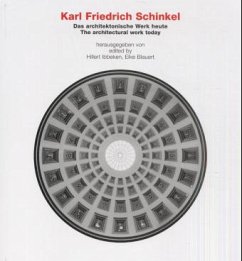There is a copious and wide-ranging body of literature on Karl Friedrich Schinkel, Germany s most important 19th-century architect. But there is not a single work that records and assembles material on buildings by Schinkel that are still standing today, one hundred and sixty years after his death, after two world wars and major political upheavals. This volume is intended to fill the gap by providing the fullest possible compilation. It is surprising how many buildings by Schinkel still exist. There are over 150 of them in 96 different places, 62 in Germany and 34 in Poland, with Berlin and Potsdam each counting as a single location. The picture is very varied as far as the individual buildings are concerned. The churches make up the greatest number: about 70 of them are still standing. Then come 30 museums, theatres, guardhouses, schools and similar buildings, 18 alaces, castles and manor houses, 12 memorials, 12 tombs, 6 interiors and 4 fonts. A glance at a map of the former stat e of Prussia shows clearly that the buildings are not distributed evenly. In the west, the Rhineland and Westphalia, there were and are relatively few buildings by Schinkel. There is a decided cluster, the first regional concentration, in the present Saxony-Anhalt, between Magdeburg and Weimar. Further to the east come major accumulations in Berlin and Potsdam, and then the Oderbruch in the east of Brandenburg as another cluster. There are also concentrations of buildings by Schinkel in the Posen area and in west Poland, but Pomerania, West and East Prussia and Silesia have far fewer. This reflects interesting historical patterns.
Heinz Schoenemann provides an introductory essay about Schinkel in his
day, Helmut Boersch-Supan has contributed accounts of the way in which
Schinkel's legacy is being handled today. The catalogue texts are by Martina Abri, Elke Blauert, Eva Boersch-Supan, Bernd Evers, Hillert Ibbeken and Heinz Schoenemann. Hillert Ibbeken, who had the idea for this proje ct, was Professor of Geology at the Freie Universitaet Berlin until his retirement; he has been involved in architectural photography throughout his life. Elke Blauert is an art historian and works on the academic staff of the Kunstbibliothek in Berlin.
Heinz Schoenemann provides an introductory essay about Schinkel in his
day, Helmut Boersch-Supan has contributed accounts of the way in which
Schinkel's legacy is being handled today. The catalogue texts are by Martina Abri, Elke Blauert, Eva Boersch-Supan, Bernd Evers, Hillert Ibbeken and Heinz Schoenemann. Hillert Ibbeken, who had the idea for this proje ct, was Professor of Geology at the Freie Universitaet Berlin until his retirement; he has been involved in architectural photography throughout his life. Elke Blauert is an art historian and works on the academic staff of the Kunstbibliothek in Berlin.

